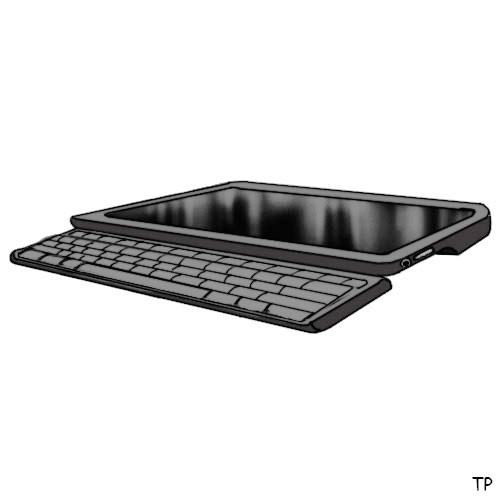Tablet PCs: First tablet PC with a slide-out keyboard. The keyboard is a full five-row QWERTY
keyboard minus the top row of function ("F") keys, numberpad on the right side, cursor pad (usually situated in front of the Space bar), or pad to rest one's wrists on. To do "F" functions, the key between a normal keyboard's "Ctrl" and "Alt" should be labeled "Function" (instead of the current Windows icon) and pressing it and one of the number keys does the same as current "F" keys on keyboards do today. This keyboard slides out from the long (length) side of the tablet PC (or iPad). When slid in, the tablet PC is the same thickness as any other normal tablet PC.
[Tablet PCs are popular because they are more compact and lightweight than laptops when you are just interested in watching a video in bed or playing a touch-screen video game while on a bus. However, their touch-screen keyboards are absolutely a joke. Because they are touch screen, you cannot actually use them without looking directly at them since there is nothing physical that tells your sense of touch that your fingertips are staying on the right keys. And if you merely rest your fingers on a touch-screen keyboard, it will start typing gibberish. Whereas constantly holding your fingers in the air above the touch-screen keyboard causes muscle fatigue in your hands and fingers. And when you do try to actually type, it is best you just use one or two fingers (one or both of your index fingers) so you can see what "keys" you're hitting since your middle, ring, and pinkie fingers are hidden from view by your index fingers thus, without you feeling the keys underneath them, it is hard for you to control what they are doing. This slide-out-keyboard tablet PC will become the descendant of the laptop and cause the death of today's tablet PC (and iPad, unless it comes out with a slide-out keyboard). The tablet PC has clearly shown that people can do without the constant presence of a keyboard and do appreciate a more compact and light weight portable computer monitor. However, nothing can be done to make the touch-screen keyboard a meaningful tool for typing. It is fatally flawed. The slide-out keyboard will be its death blow.]
Future Challenges: 1) An ergonomic keyboard.
2) A bar mechanism that raises the tablet up at a slight angle when the keyboard is slid out. The fully slid out keyboard is hinged so it can lay flat while the tablet is propped up at a slight angle. [This tilting of the tablet will make it easier for people to see what they're typing. By making it a bar (likely a spring-loaded bar that is shaped like a tablet-wide "U"), people can be assisted by it when resting the tablet PC on their laps. If this were instead done by two legs, the legs could slip off one side or the other of the human's legs and/or cause unnecessary and unwanted pressure points on those legs.
And it is this bar mechanism which will most likely enable the slide-out-keyboard tablet PC to replace current laptops for it shifts the weight of the machine from the keyboard area to the monitor area. Presently, laptops have their keyboard areas weigh more than enough so their monitors can hang past the upright position point and tilt away from the laptop user. Using the bar mechanism enables the monitor to be tilted up for easier viewing by typists while not requiring anything from the keyboard. No more over-heated laps. No more heavy keyboards. This innovation will result in a steady reduction in weight of the machine which will be appreciated more and more by people who actually try to type with the machine on their laps. In a very real way, these more compact and lighter slide-out-keyboard tablet PCs will be what laptops were always meant to be: something small, light, and cool enough to comfortably use on one's lap.]
3) A slide-out thumb keyboard that slides out of the short (width) end of the tablet PC. [For those pre-teen and teenagers who learned to first type with their cellphone's thumb keyboard and never with a full keyboard, this tablet PC will be the one they will be clamoring for.] The keyboard must have two long curved grooves on its back that enable the thumb typists to more grab hold of the entire tablet PC with their other fingers (index, middle, ring, and pinkie) so the typist can easily tilt the entire thing up for more easy viewing of what they're typing.
4) The keyboard-slide-out tablet PC of the original challenge with a five-row Dvorak keyboard layout.
5) A combination of FC #1, 2, and 4.
6) Same as FC #5 but the keyboard's keys containing small read-out screens (possibly LED or e-ink) which enable them to switch between five-row QWERTY and Dvorak keyboard layouts with the press of a button.

